und Wörterbuch
des Klassischen Maya



A Looted Maya Fragmentary Sculpture from La Corona, Petén, Guatemala
Research Note 28
February 2, 2024
DOI: https://doi.org/10.20376/IDIOM-23665556.24.rn028.en
Sebastián Matteo (Independent Researcher, Brussels)
Introduction
Even though the heyday of the looting of Mayan artifacts is now behind us, the consequences of these destructive activities are still felt to this day. Even when such contraband pieces resurface, during a public sale or a donation to a public collection, the loss of information specific to the archaeological context and of what is deductible from it remains forever irreversible (see, e.g., Tremain and Yates 2019; Paredes and Krempel 2019). This leaves us with an object completely disconnected from its context, even if occasional complementary finds during scientific excavations at a particular site, allow statements and speculations about the original context. The documentation of unprovenanced monuments, and their dissemination is therefore essential, as evidenced, for example, by the remarkable works of Karl Herbert Mayer and Ian Graham. Mayer has been publishing numerous articles and books on looted Maya monuments and collections since the 1970s. Graham spent decades of his life with documenting Maya monuments in situ, of which some got looted and cut into pieces and entered the circuit of trafficking works of art (see Graham 2010). To Mayer’s and Graham’s monumental works add many other smaller scaled studies and publications that have allowed and still continue to fuel the expansion of our knowledge, whether by collecting, documenting, informing, exchanging or publishing data related to looted objects. Thus, every bit of information available helps to reconstruct the original context of the various artefact corpora, whether they are monuments or portable artifacts, either inscribed or not.
The topic of this article is a monument known until recently only from a single photograph, published here for the first time, but already analyzed in a previous publication (Matteo 2010). Having obtained permission to make the photograph public, I decided to update my previous note, and embellish it with more contextual information.
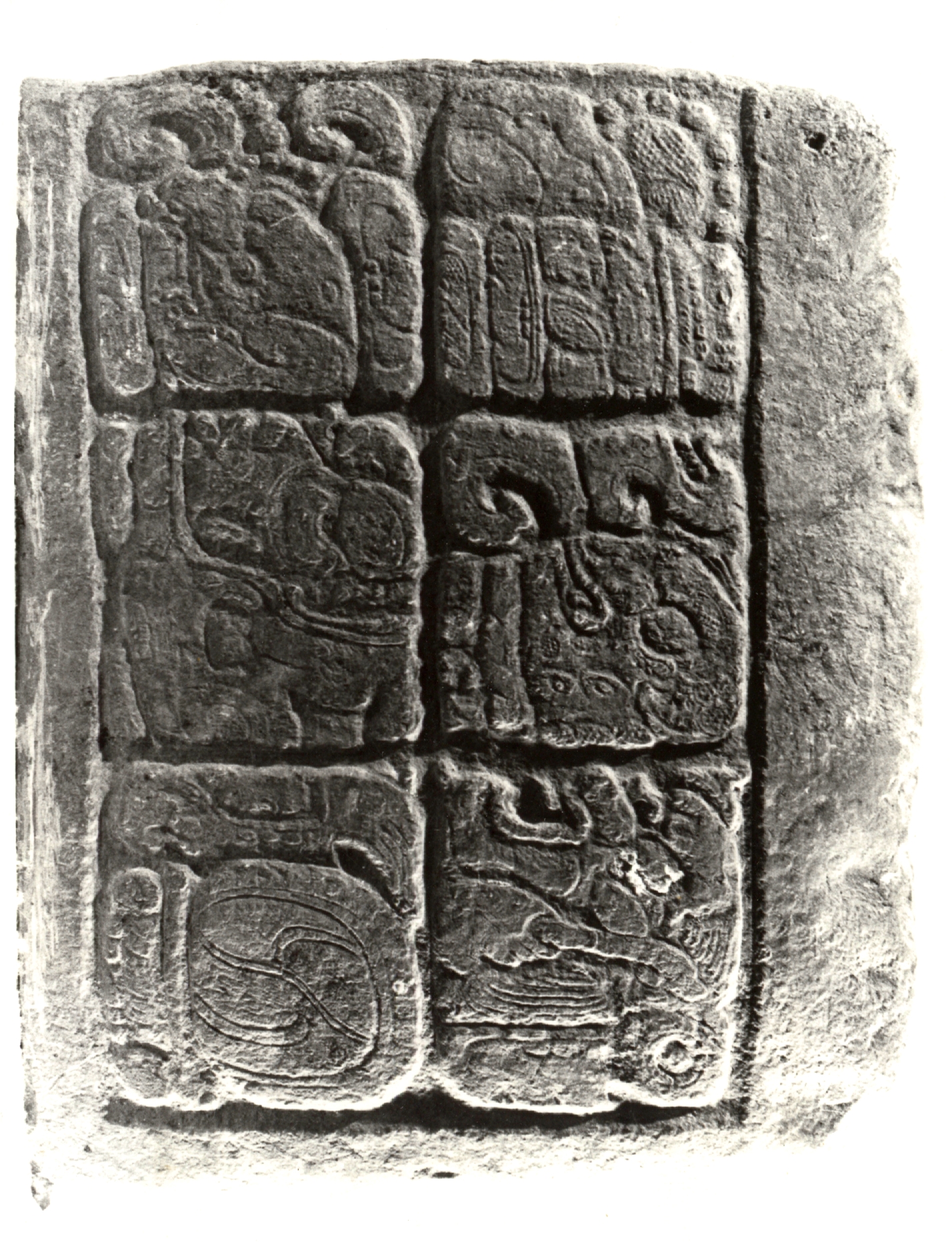
|
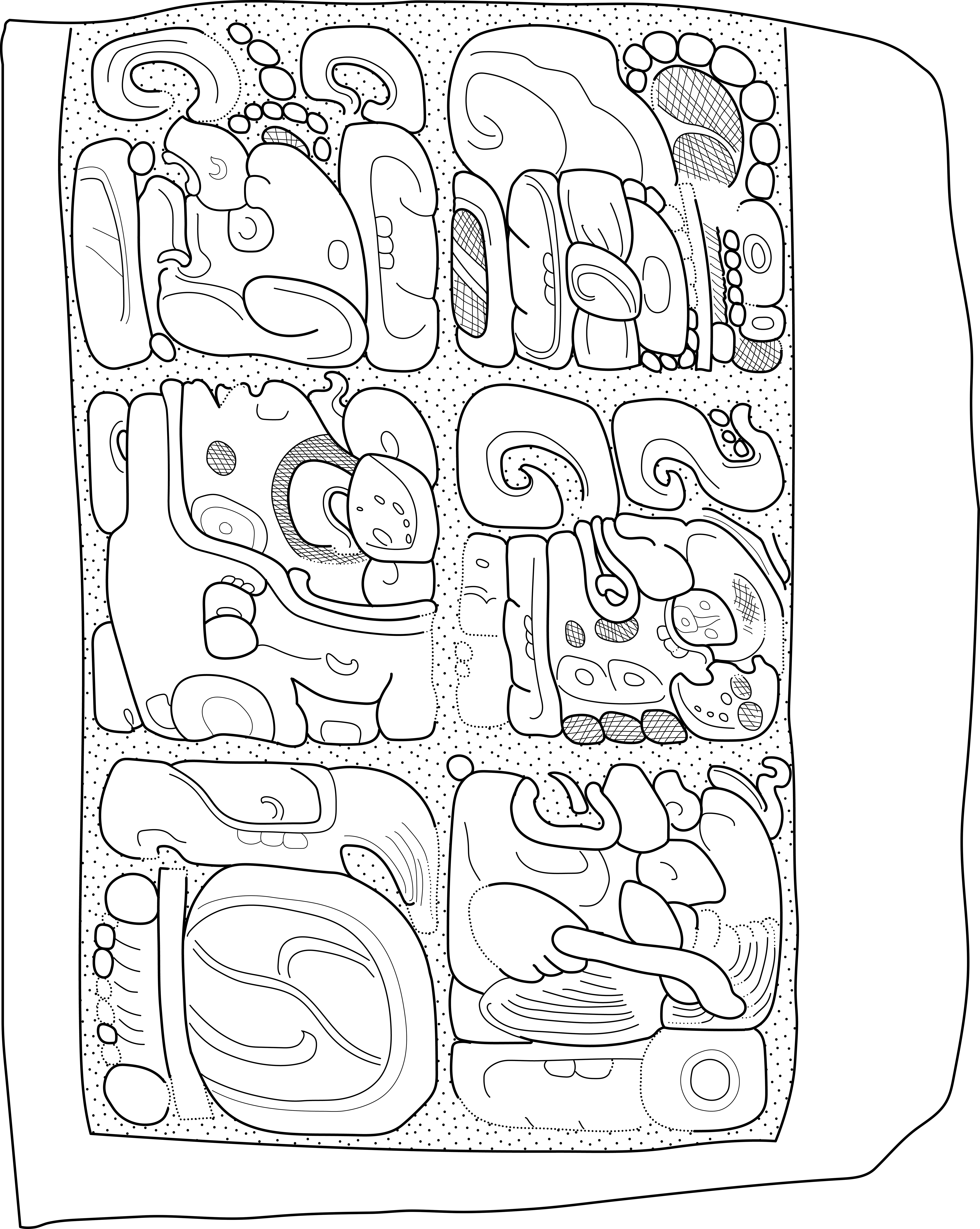
|
| Figure 1. La Corona, Element 25 of La Corona, Hieroglyphic Stairway 2, Set B. Private collection (ex-collection Prigogine <1970-2009?). Traces of modern cuts are visible on the lower edge (Photograph from the Documentation Fund of the Americas section of the MRAH, edited by Sebastián Matteo). Link to image in the Maya Image Archive. | Figure 2. La Corona, Element 25 of La Corona, Hieroglyphic Stairway 2, Set B. Private collection (ex-collection Prigogine <1970-2009?, drawing by Sebastián Matteo). CC-BY 4.0. Link to image in Maya Image Archive. |
A Monument from La Corona
In 2010, while investigating the personal archives of the late German researcher Heinrich Berlin (1915–1988) in the custody of the Musées Royaux d’Art et d’Histoire in Brussels (see Matteo and Peperstraete 2010), we found an unlisted cardboard box containing various files, binders and envelopes that apparently belonged to Georgette Van Swieten, former curator of the Americas section of the Museum (1966–1985). In this heterogeneous set, one particular photograph caught our attention (Figures 1 and 2). This image shows a then unknown monument that will be discussed in this note. Thanks to its characteristic carving style and textual content, this monument is perfectly attributable to a particular monumental corpus. It is undoubtedly a monument from La Corona, an archaeological site located in the west of the Guatemalan Peten and at the center of a puzzle that confused archaeologists and epigraphers since the 1970s until the year 2005. Before analyzing this monument, I will return to the progressive discovery of this Maya site which well-illustrates the problems generated by the looting of archaeological sites that still concerns so many artifacts and monuments today orphaned. We will come back later to the new information collected on this monument since our publication in 2010.
The Site Q Issue
All these monuments that we now know of, are of Guatemalan origin and have resided in the United States, Mexico, Europe (Belgium, France, Switzerland), but also in Australia (Mayer 1995: 93, Graham 2010: 491), and, most likely, elsewhere as well. Several monuments of La Corona have passed through Belgium, or are probably still there, preserved in still unknown collections (Panel 2, Fragment 1, Element 25, Element 20 (Mayer 1987: 16–17, Plates 66, 67)). It is currently known that most of the looting took place in the 1960s (Stuart et al. 2015a: 25). It was from this corpus scattered in private and public collections that the first epigraphic work was carried out, trying to reconstruct the history of “Site Q” (Mathews 1998; Ringle 1985; Martin 1991). The La Corona site was nicknamed Site Q, “Site What” (or “sitio que” in Spanish), due to the lack of knowing where it was located (see Graham 1988, 1997, 2002; Guenter 2005, Canuto and Barrientos 2009, 2013). In fact, as soon as the mid-sixties, monuments began to appear on the art market, apparently originating from the same still unknown site (see, for example, Bucher 1966), given their content mentioning the names of different individuals belonging to the same lineage. Some individuals revolving around this family carried the emblem title, k’uhul kaan ajaw, "divine lord of Kaan", probably attributable to the site of Calakmul (Joyce 1973), an assumption which would be confirmed later in time. It was noted that the individuals carrying this emblem title appeared to be superior to those at Site Q. They oversaw local ceremonies at La Corona, and created family ties through the intermarriage and union of their royal daughters to the male elite of La Corona during at least three consecutive generations (see Stuart et al. 2014; Martin 2008).
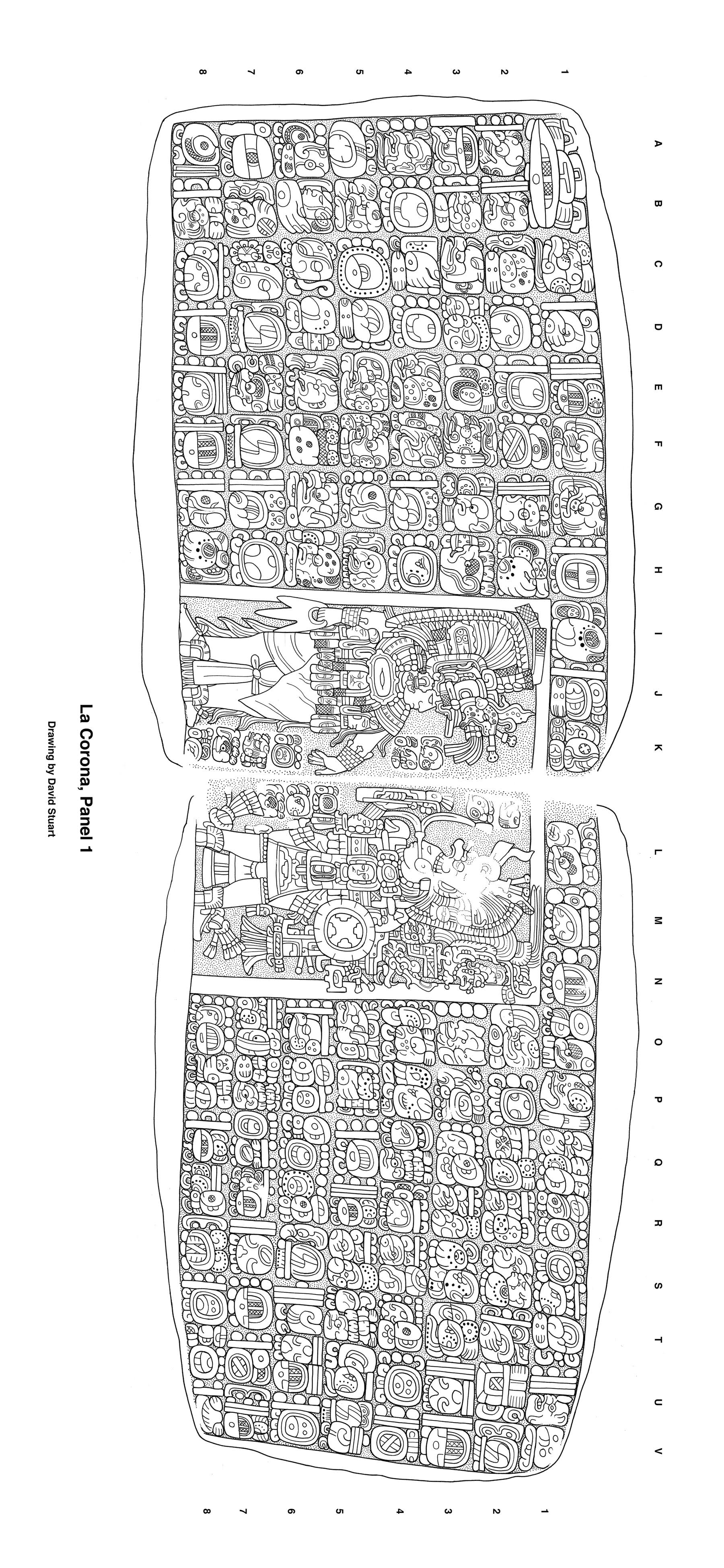
|
| Figure 3. La Corona, Panel 1, found in situ in 2005 (drawing courtesy of David Stuart). Copyright reserved. |
The first concrete, though preliminary arguments for identifying “Site Q” were published in 1997. An expedition to the newly discovered Guatemalan site in La Corona ("The Crown") revealed features implying that these ruins could be the place of origin of the “Site Q” sculptures (Graham 1997, 2010: 495; Stuart 2001; Canuto and Barrientos 2013: 1). This site was discovered by mayanists thanks to a series of fortuitous events narrated by Ian Graham in his final work (Graham 2010: 491–496). The fact of having found cut monuments and inscriptions that could possibly be associated with the looted monuments allowed this postulate. Excavations began during a second mission in 2005, under the aegis of the Proyecto Arqueológico El Perú-Waka’ (Canuto and Barrientos 2013: 1-2), and immediately confirmed the previous suspicions when Marcello Canuto discovered a sculpture which was named Panel 1 of La Corona. This monument, made up of two very well-preserved sections (Figure 3), mentions many details of local history, as well as characters associated with the “Site Q” emblem glyph, such as K'inich Yook, a king mentioned in the corpus of “Site Q” (Stuart et al. 2015a: 30). Thus, the longstanding question regarding the geographical origin of the pillaged monuments could finally be answered.
According to the inscriptions from La Corona, the city was anciently named Saknikte’, “White Flower”, identified as Plumeria alba. This term is only used as a toponym, and not as an emblem glyph, a title, which is associated with a specific dynasty, but not attested yet as La Corona itself (Stuart et al. 2014: 436). The site therefore does not have an emblem glyph, a case apart, although it maintains very special and strong links with a superpower, Calakmul, ruled by kings wearing the emblem glyph that designates them as "divine lords of Kaan" (k'uhul kaan ajaw).
The monuments associated with La Corona received a rather complicated first nomenclature, due to the many names given to these dispersed pieces before being able to locate them and initiate their systematic classification. Only recently, a first base for a systematic nomenclature has been laid (see Stuart et al. 2015a, Stuart et al. 2015b). The monument analyzed in this article was not named when first published (Matteo 2010), but is now called Element 25 (Stuart et al. 2015a: 38), according to the new nomenclature and following the recommendations by Marcello Canuto (p.c. 2010). Since in situ discoveries have been numerous since the launch of the Proyecto Arqueológico La Corona (PRALC), it seems obvious that there are other monuments to be found in private collections given the difficulty of connecting together the many monuments gathered in the current corpus, proof of its significant incompleteness. As we will see at the level of the inscription later, Element 25 (Figures 1, 2) could have been extracted by the looters from La Corona, Hieroglyphic Stairway 2, where monuments with epigraphic and stylistic similarities have been found (Stuart et al. 2015a). However, a problem arises. The inhabitants of the city, during a remodeling of the staircase associated with Structure 13R-10, reused the carved blocks which were rearranged in an incorrect order, mixing various monuments that originated from different sculptural programs/construction phases (Stuart et al. 2015b: 5-6). There seem to be in fact three sculptural groups found in this disordered staircase: i.e. La Corona, Hieroglyphic Stairway 2, but also Groups A and B as proposed by David Stuart, of which one part was found still in situ and the other part reconstructed from looted monuments (4 out of 21 for Group A, and 11 out of 13 for Group B, see Stuart et al. 2015b: 5-6). It therefore seems possible that the Group B blocks were made for another architectural structure, from which they could have been extracted, either by the former inhabitants during the remodeling of the Hieroglyphic Stairway 2, or/and by the looters. According to these assumptions, Element 25 therefore forms part of Group B together with Elements 1, 2, 3, 4, 5, 6, 7, 8, 9, 20, 38, 29 (in situ) and 32 (in situ) (Stuart et al. 2015b: 9).
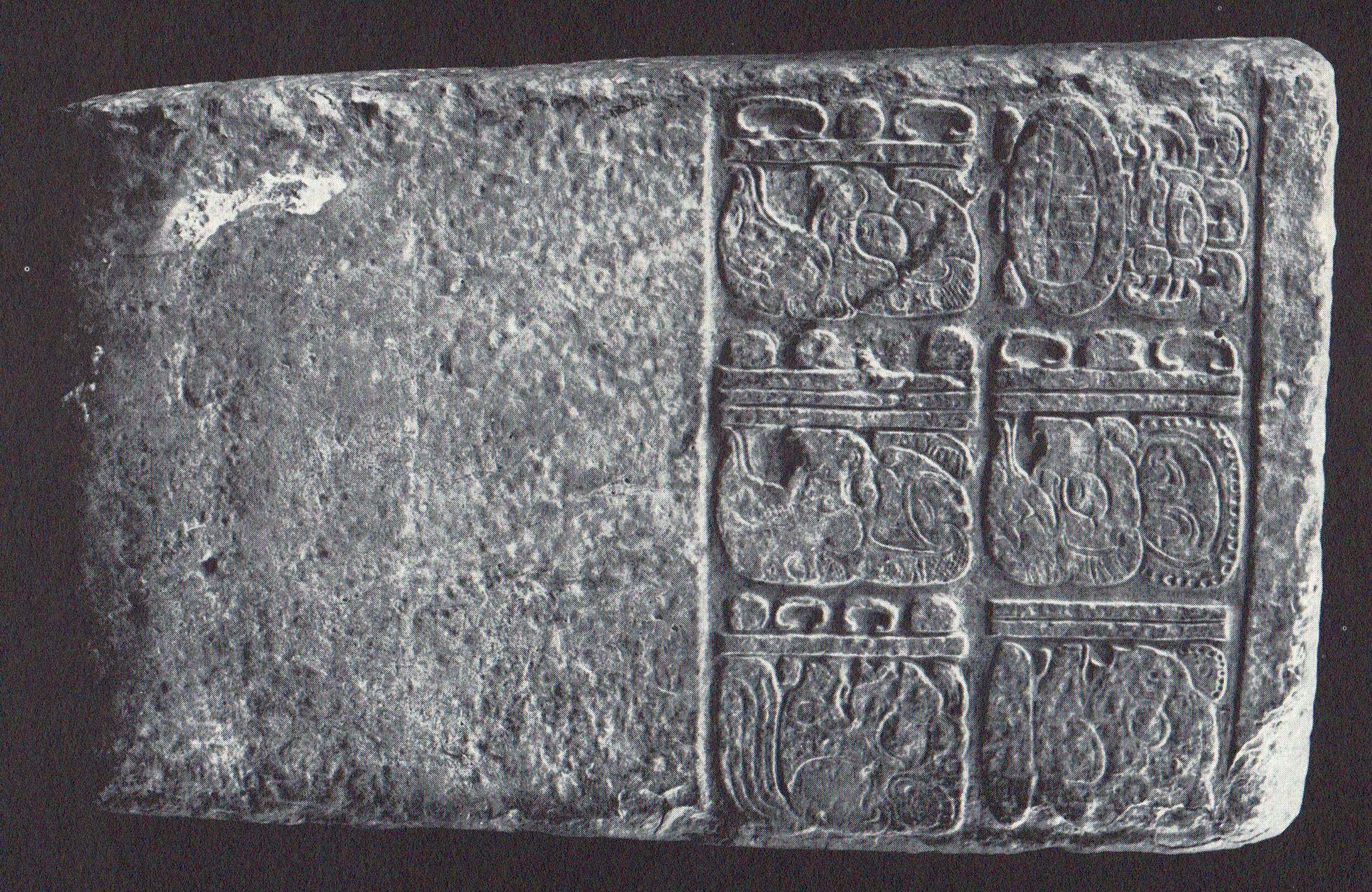
|
|
Figure 4. La Corona, Element 1 of La Corona, Hieroglyphic Stairway 2, Set B. This element is still complete and its shape may hint to the original shape of Elements 2, 4 and 25 (Image cited from: Mayer 1978:20-21). Image source: Author unknown. This image is used for scientific purposes under the assumption of fair use. |
Description of the Monument
The parallelepipedal shaped stone block is carved with six hieroglyphic blocks on its front face, organized in three columns of two rows, and bordered on three sides except the left side, showing that the beginning and the rest of the text is to be found on another monument, or even on several ones. The text has been very finely carved by a very skilled and expressive hand. If we take a closer look at the photograph published here (Figure 1), we will note that the lower part shows rectilinear traces of modern cutting, of a lighter shade (the stone being more freshly fractured). These traces correspond to the cut made by looters of part of the block in order to lighten it for transportation out of the Peten forests. This hypothesis is also based on the fact that Element 1 (also looted, Figure 4), which also seems to be part of Group B of Hieroglyphic Stairway 2 (Stuart et al. 2015b), shows a more developed lower plainly cut surface which probably corresponds to the type of fragment that was cut by the looters. Other pieces in Group B of Hieroglyphic Stairway 2 show similar damage (Elements 2, 4 (Figures 5, 6)). These cuts were undoubtedly made with powered tools brought into the Guatemalan forest. Would it be possible to find the carcasses of these monuments on the site in order to see where they came from? Several of these carcasses have been found in La Corona, one of which has been re-associated with a looted monument now in Dallas (Ponce Stokvis 2013: 165-166, Fig. 8.26).
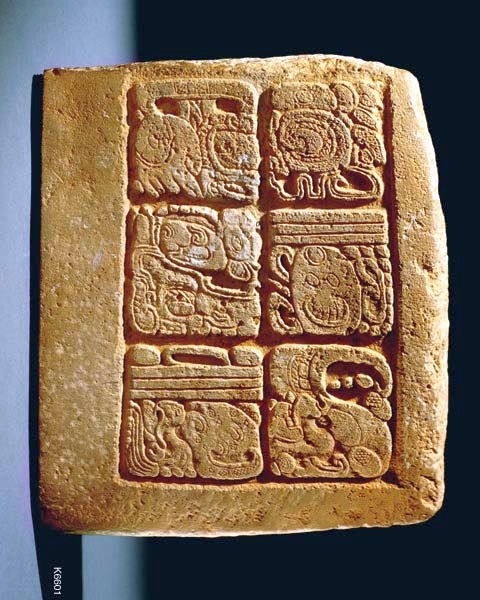
|
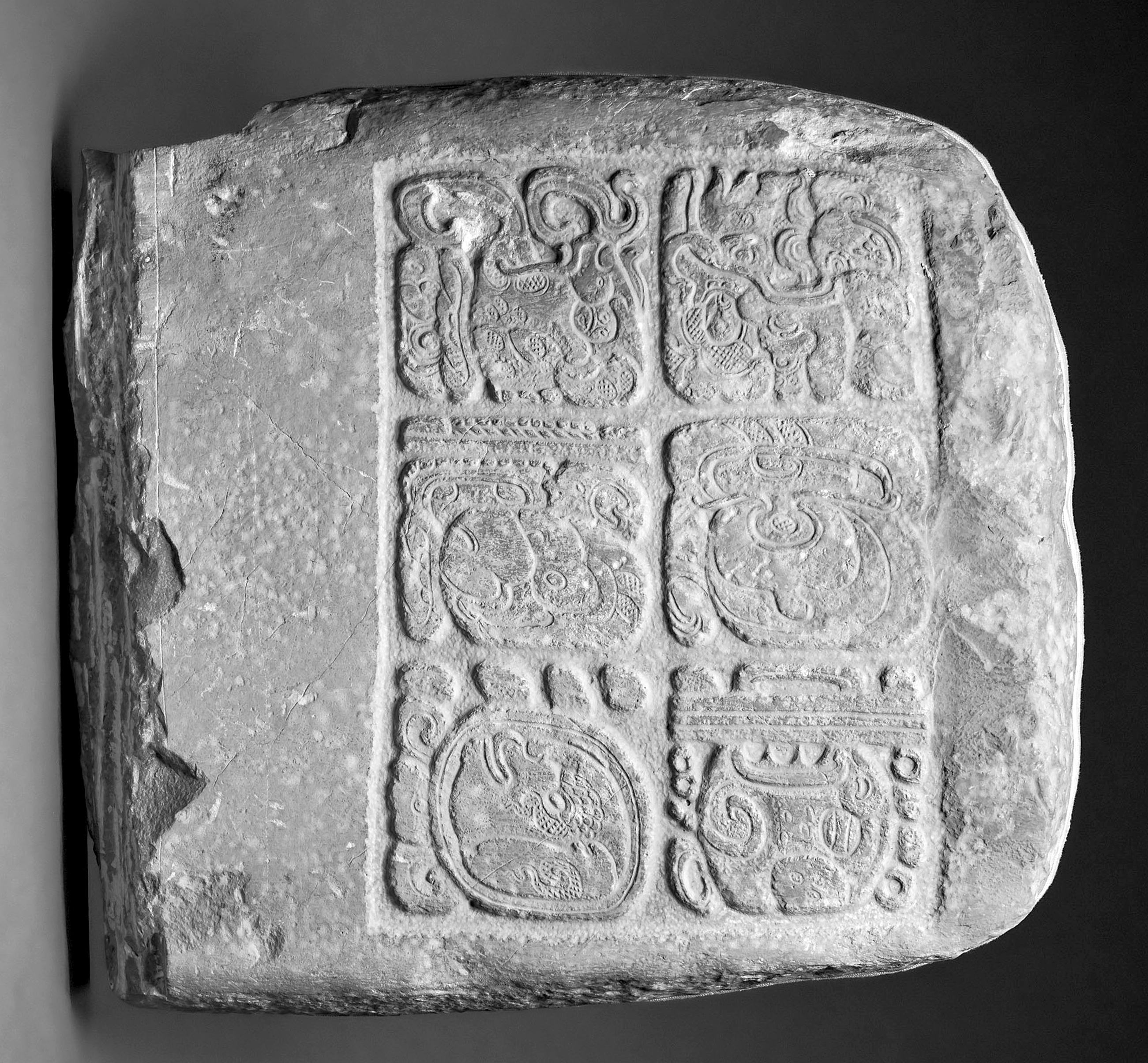
|
| Figure 5. La Corona, Element 2 of La Corona, Hieroglyphic Stairway 2, Set B. Traces of modern cuts are visible on the lower edge (photograph courtesy of Justin Kerr, Kerr 6601). | Figure 6. La Corona, Element 4 of La Corona, Hieroglyphic Stairway 2, Set B. (1970.101, Art Institute of Chicago). Traces of modern cuts are visible on the lower edge. CC PDM 4.0 |
Actual Whereabouts of La Corona, Element 25
While it is currently impossible to answer this question, since the publication of our first study in 2010, some information at the time still unconfirmed could be verified. By cross-checking the information found in various publications (Van Lerberghe 1970; Mayer 1995: 93) with those collected by Karl Herbert Mayer, Donald Hales, and Guido Krempel (p.c. between 2010 and 2021), we now know that Element 25 belonged to Ilya Prigogine (1917-2003), a former student and professor at the Université Libre de Bruxelles, Belgium. It now also seems certain that Element 20 of La Corona (Figure 7) had also passed into the hands of Ilya Prigogine, and was probably acquired in Belgium just like Element 25, at the latest in 1970 (cf. Van Lerberghe 1970: cat. 279 and 303). The Nobel Prize for Chemistry laureate Prigogine was known to have owned a collection of pre-Columbian art, of which a large part was put up for sale fifteen years after his death via several auction houses in 2018, including Christie's and Art Richelieu-Castor-Hara-Deburaux (Thery 2018). However, his ownership of Element 25 remained to be confirmed, since this monument was not part of these sales. Guido Krempel (p.c. 2021) recently informed me that in 2009 Element 25 was actually resold by Bonhams, whose catalog lists Ilya Prigogine as the previous and last owner of the artifact (Bonhams 2009: lot 443). Important too, the dimensions of the sculpture are given (20 x 25 x 3 cm). A Belgian exhibition catalog seems to show that Ilya Prigogine owned this Element 25 as early as 1970, as well as Element 20 (Figure 7)[1]. It was in fact discreetly mentioned just in a commentary in the catalog, without a photograph of the monument, that it belonged to the "Collection P." (cf. Van Lerberghe 1970: cat. 279, 303). This notice is associated with a monument with measures (20 x 24 cm) very close to those given in Bonhams (20 x 25 x 3 cm), which supports the hypothesis of our sources. The information found on the website of the Bonhams auction house gives slightly different dimensions, but presents a new figure, the thickness of the block, of 3 centimeters. We now know that the block has been cut to reduce its thickness, which made it even easier to handle for the looters after removing it from its original context. Element 20, which was part of the same collection, was put on sale by Sotheby's in 2001 (Sotheby’s 2001: lot 544). It is remarkable that Element 4 was acquired in 1970 by the Art Institute of Chicago (1970.101), in exactly the same year as Elements 25 and 20 by Ilya Prigogine.
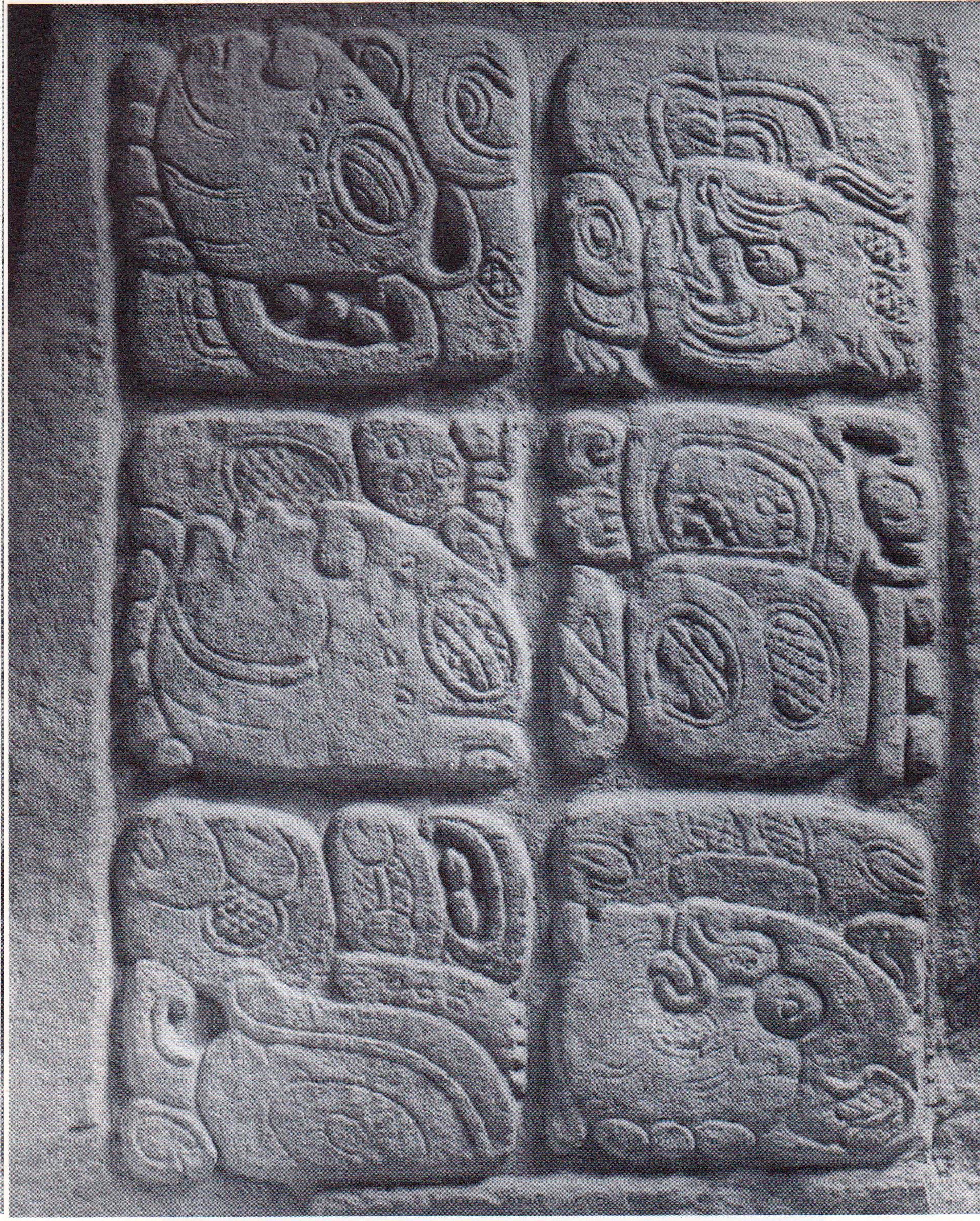
|
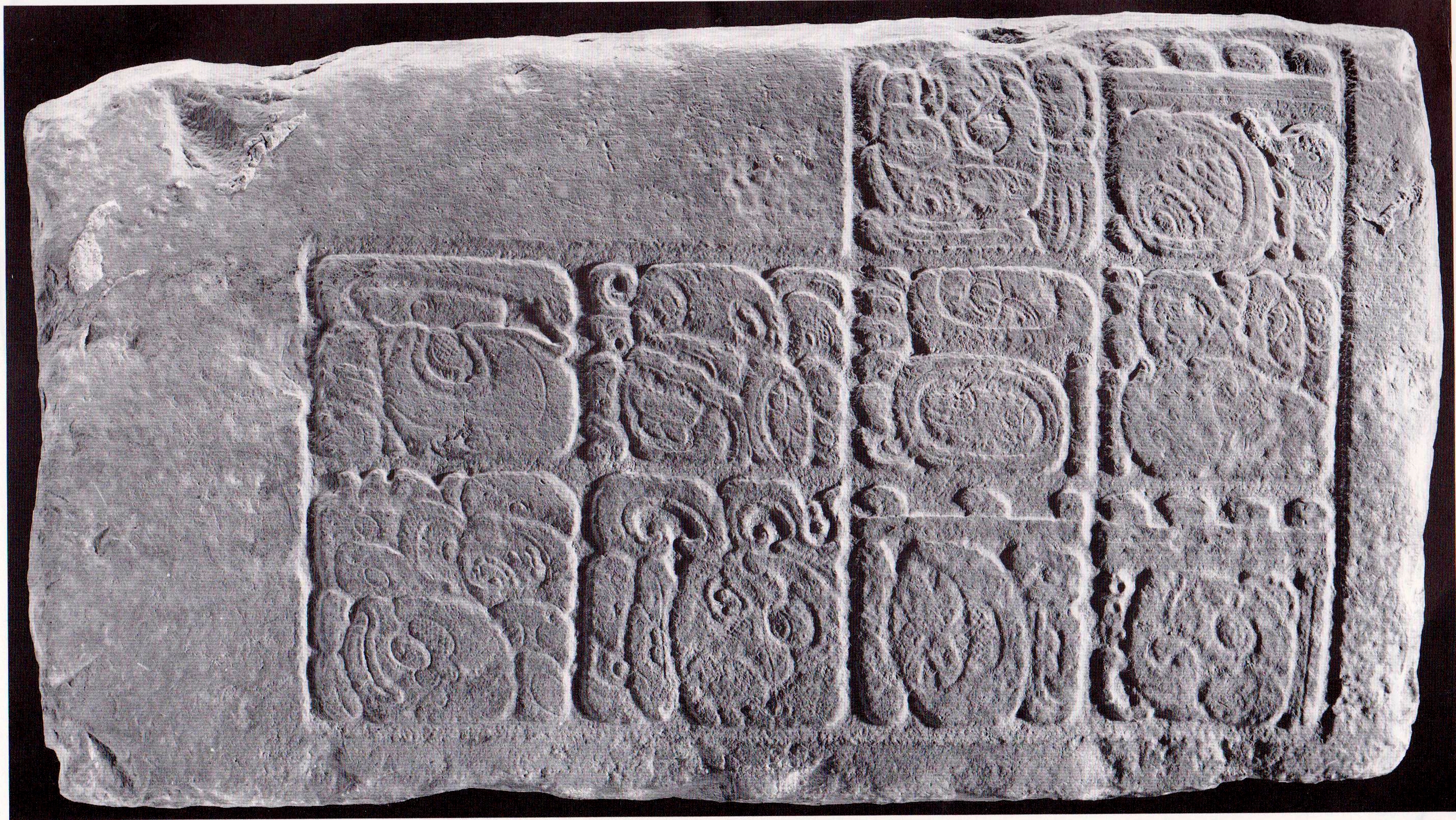
|
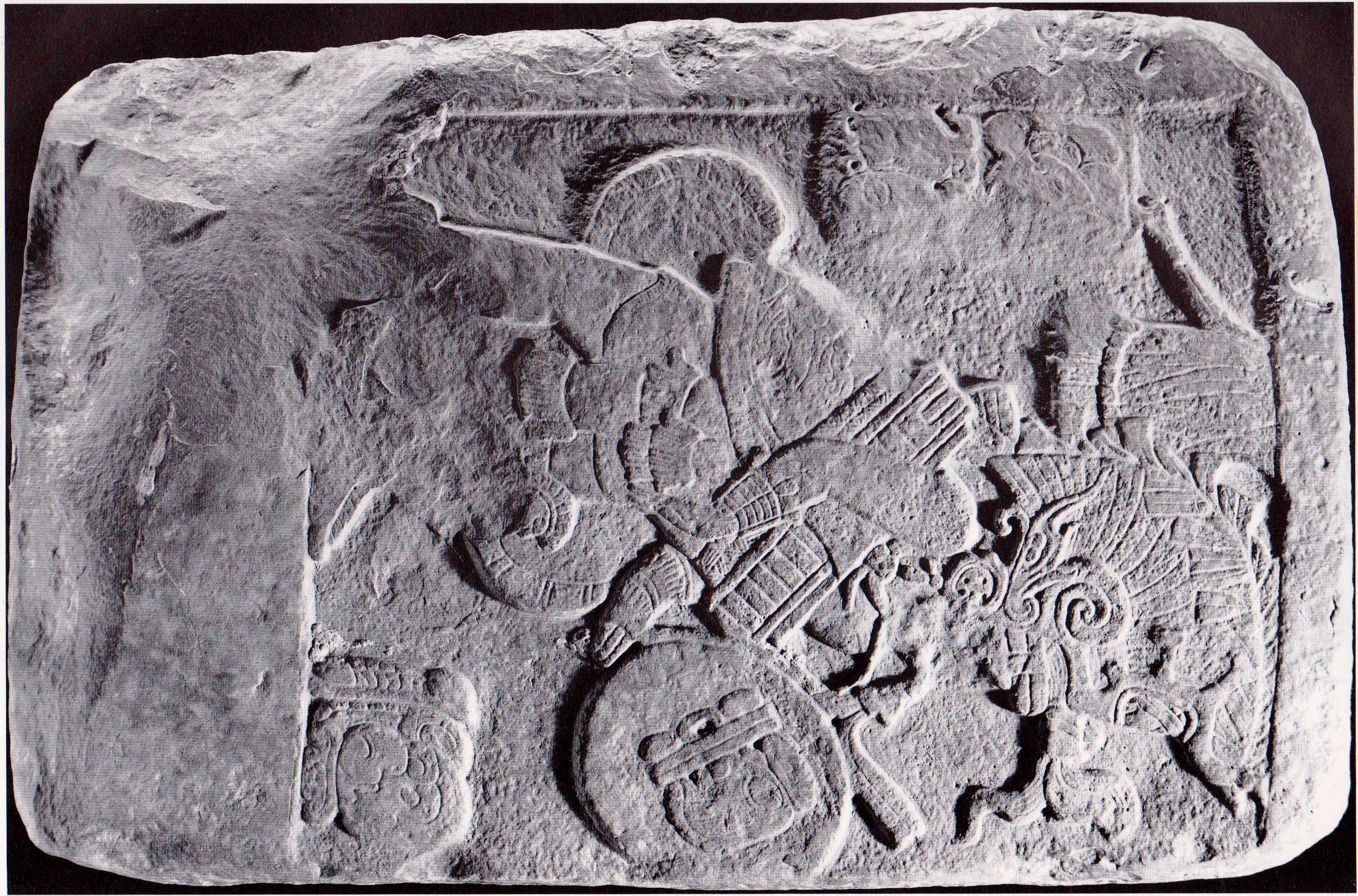
|
| Figure 7. La Corona, Element 20 of La Corona, Hieroglyphic Stairway 2, Set B. Private Collection (ex-collection Prigogine (<1970-2001) (Image cited from: Mayer 1987: Cat. No. 6). Image source: Author unknown. This image is used for scientific purposes under the assumption of fair use. | Figure 8. La Corona, Element 6 of La Corona, Hieroglyphic Stairway 2, Set B. Private collection (Image cited from: Mayer 1995: Plate 80). Image source: Author unknown. This image is used for scientific purposes under the assumption of fair use. | Figure 9. La Corona, Element 14. Private collection (Image cited from: Mayer 1995: Plate 76). Image source: Author unknown. This image is used for scientific purposes under the assumption of fair use. |
Analysis of the Hieroglyphic Text
The text appearing on La Corona, Element 25 constitutes part of a longer sentence covering several monuments, themselves forming a longer inscription which, as we have seen above, cannot be reconstructed at the moment, nor attributed with certainty to Hieroglyphic Stairway 2. The six hieroglyphic blocks nevertheless present important information specific to this monument.
| (A1) T'AB[yi]-ti-a-K'UH-HUN-na-li (B1) K'AHK'-WAHY-na-a (A2) ya-na-bi-li (B2) T1837-KAN[AJAW]-wa (A3) KAL-TE' (B3) u-TZ'AK-a |
| t'abaay ti aj k'uhuunil k'ahk' wahy na' ya[j]naabil ? kaan ajaw kal[oom]te' u tz'aka |
| "K'ahk' Wahy Na' was raised into ajk’uhuunship. He is the ajnaab of “Yuknoom Head” Kaan Ajaw, kaloomte’. It was counted ...[x days]..." |
The text mentions two individuals already known in La Corona: K'ahk' Wahy Na' and “Yuknoom Head” Kaan Ajaw"[2]. The latter was a king of the important city of Calakmul (Kaan dynasty) from 698 AD until at least 731 AD. (Martin and Grube 2008: 112; Stuart et al. 2015). The first character mentioned, K'ahk' Wahy Na', is only known from monuments of La Corona at this time, and it is therefore likely that he belonged to the elite of that city. He is named only on the blocks of the Hieroglyphic Stairway 2 of La Corona: three times in the presence of the king of Calakmul who came in person to the city (Elements 4, 6, 25), one time accompanying a kaloomte', plausibly “Yuknoom Head” Kaan Ajaw from Calakmul (Element 40), and once just on his own (Element 14, Figure 9):
| La Corona, Element 4 | K’ahk’ Wahy Na’ as ajk'uhuun, and watching an activity performed by “Yuknoom Head” Kaan Ajaw |
| La Corona, Element 6 | K’ahk’ Wahy Na’ inaugurating a building, accompanied by “Yuknoom Head” Kaan Ajaw |
| La Corona, Element 25 | K’ahk’ Wahy Na’ rising as ajk'uhuun, and mentioned as the ajnaab of “Yuknoom Head” Kaan Ajaw |
| La Corona, Element 40 | K’ahk’ Wahy Na’ as ajk'uhuun accompanying an unnamed kaloomte' |
| La Corona, Element 14 | K’ahk’ Wahy Na’ playing ball, carrying the title of ajk’uhuun |
La Corona, Element 25 mentions an event unknown to the other inscriptions associated with the individuals we have just mentioned. In fact, the text celebrates the rise in rank of K’ahk’ Wahy Na' who receives the title of ajk’uhuun, “worshipper” (Zender 2004: 154, 191). The verb describing this "ascent", t'ab, "to climb", is represented by steps of stairs (sign T843), and is to our knowledge, the only example of the Mayan corpus using this expression to refer to an accession. This sign, and therefore this term, is normally used in contexts of displacement ("to climb, to flee") or of dedication ("to inaugurate") of monuments or structures. In the case of the La Corona, Element 25, this term therefore refers to the “elevation” of this individual to the rank of ajk’uhuun, a title designating dignitaries associated with a religious function. As mentioned before, despite the fact that this individual carries this title in three other cases (Elements 4, 14 and 40, Figures 3, 5), this event is not mentioned elsewhere. Unfortunately, it is impossible to reconstruct the date of this celebration, which should constitute the beginning of the sentence, since the monument does not present any calendrical statement. The date associated with this event is likely to be found on a monument yet unknown. However, this event must have happened prior to March 715 AD, since this date, appearing on Element 6 (see below), is associated with K'ahk' Wahy Na' bearing his ajk'uhuun title, and should thus be posterior.
Another interesting aspect of this inscription is the expression y-ajnaab-il (Figure 1, Block A2). The term ajnaab is actually another title. It is carried by K'ahk' Wahy Na', but in a possessed form (y -...- il, "his, her, its") relating him to another individual, who is none other than the lord of Calakmul “Yuknoom Head” Kaan Ajaw. Thus, K’ahk’ Wahy Na' was the ajnaab of this lord. Although the title of ajnaab is quite widespread, it still poses problems of translation and therefore of interpretation. Thus, it is difficult to know what activity or role it refers to (Zender 2004: 223; Sheseña 2008). However, it is found associated with signatures of sculptors, ajk’uhuun, as well as individuals subordinate to kaloomte’ (Krempel et al. 2021), a supreme title that is found associated with the king of Calakmul on the monument described here. If we come back to the fact that the individual bearing the title of ajnaab is here possessed by “Yuknoom Head” Kaan Ajaw, this makes it possible to demonstrate that in this tandem of important characters, it is indeed the individual of La Corona, K'ahk' Wahy Na', who is subordinate to the lord of Calakmul, since he is "his ajnaab". This inscription is therefore the first to establish that this noble of La Corona is subservient to Calakmul, and precisely to “Yuknoom Head” Kaan Ajaw. Unfortunately, we do not know more about the identity of K'ahk' Wahy Na', although there is a depiction of him engaged in a ball game (Element 14, Figure 9) and which could pair with another yet unknown element. It has been proposed elsewhere (Whittington 2001: 240) that Element 14 may be coupled with Element 17 (Kislak Foundation, 95.15.00, see Mayer 1980: Plate 60), a proposal that cannot be verified for the moment.
The presence of a king of Calakmul in La Corona is not surprising, since three other kings of this super power are mentioned repeatedly in the older inscriptions of La Corona, Tuun K'ab Hix (<520-546> AD), Yuknoom Ch'een (636-686 AD), and Yuknoom Yich'aahk K'ahk' (686-697 AD) (cf. Martin and Grube 2008; Stuart et al. 2015c). Furthermore, several of these kings had one of their daughters getting married to a lord from La Corona (see Martin 2008).
As previously stated, it is not yet clear when the event mentioned in Element 25 took place. However, there are three dates associated with K’ahk’ Wahy Na’, which give an idea of the chronological framework. Element 6 of the Hieroglyphic Stairway 2 of La Corona (Figure 8) mentions two dates which, associated with that of Calakmul and its king “Yuknoom Head” Kaan Ajaw (698-731> AD (see Stuart et al. 2015c), allow us to frame the events involving the two protagonists, since they are again mentioned together, participating in the very same event. Another date appears on Element 40, and mentions un unidentified event involving an individual bearing the kaloomte' title who was accompanied by K'ahk' Wahy Na'. Due to the fact that the kaloomte' mentioned with K'ahk' Wahy Na' is in three cases 'Yuknoom Head' Kaan Ajaw, the kaloomte' appearing on Element 40 could be the Calakmul king.
| La Corona, Element 6 | 9.14.2.12.16 | *7 Kib 14 Chen[3] | August 7, 714 AD[4] | Beginning of construction (Structure 13R-10?) |
| La Corona, Element 6 | 9.14.3.5.15 | 5 Men 8 Uo | March 14, 715 AD | Inauguration of a structure (Structure 13R-10?) |
| La Corona, Element 40 | 9.14.6.0.16 | *11 Kib 19 Kankin | November 19, 717 AD | Unidentified event involving an unnamed kaloomte' |
Element 6 (Figure 8) is therefore centered on the construction, and the inauguration of a building, Structure 13R-10, if we consider Group B as associated with Hieroglyphic Stairway 2 (Canuto et al. 2009: 34). The building would belong to an entity, probably divine, whose name cannot be read with certainty (Figure 8, position B1b). So far, these dates are the only ones from Group B of Hieroglyphic Stairway 2 and associated with these two individuals that can be calculated.
Data on this epoch at La Corona's history are rather limited, as we do not know who the ruler was during the events related to K’ahk’ Wahy Na’. As of yet, the genealogy of this individual is not mentioned anywhere, which is normally the case with kings identified at La Corona. In addition, the fact that this individual carries titles of high rank, but secondary since subservient to royal power, suggests that he was not a king. According to some, he could be the son of King Yajawte’ K’inich (<721-731> AD) (Stuart et al. 2014: 441). However, this is still a hypothesis, since no information about their relation occurs in the inscriptions. There might even had existed another yet unknown king, preceding Yajawte’ K’inich. Indeed, as the authors of these ideas themselves state, under Yajawte' K'inich there might have happened a shift from La Corona's long alliance with Calakmul (Kaan), toward that kingdom’s rival, Tikal (Mutul), by marrying a wife from Mutul in 791 AD (see Altar 4) an idea also proposed by Nikolai Grube (2013: 132).
Final Remarks
The epigraphic analysis of this decontextualized monument adds new insights on the history of the elite of La Corona, and deepens our understanding of the links that the elite of this Guatemalan site had with the Kaan dynasty, at the time residing in Calakmul. Element 25 is therefore in line with various monuments that detail the matrimonial ties that existed between these two dynasties, but also the local events attended by the lords of Calakmul visiting La Corona. My note also clearly illustrates the serious problems caused by the looting of archaeological material. In fact, a much clearer synthesis of La Corona’s history could undoubtedly have been achieved if these monuments had not been looted. The information collected so far is certainly only part of what could have been reconstructed if these monuments had been discovered in situ. As has been detailed, Element 25 is part of a much larger corpus, already illustrated and analyzed in numerous disperse publications. That corpus will finally be compiled and published in the volumes of the Corpus of Maya Hieroglyphic Inscriptions in the years to come (David Stuart, p.c. March 2021). However, it is obvious that only part of the entire original corpus is known to the current scientific community for the time being.
Acknowledgements
The author would like to thank Karl Herbert Mayer for his permission to reproduce the photographs that had been provided to him anonymously, as well as for his information regarding the Prigogine collection. Donald Hales is also to be thanked for sharing data about La Corona, Elements 20 and 25. The author also wishes to thank the Art Institute of Chicago for making most of the photographs available free of charge in their online database, but also Justin Kerr for providing his photograph of La Corona, Element 2. Finally, I wish to thank Guido Krempel and Sergei Vepretskii for their constructive comments and corrections, as well as Serge Lemaitre for information relating to the history of the Musées Royaux d'Art et d'Histoire. To Louisa Colin.
References
Bonhams
2009 Pictures, Furniture, Tribal, European & Oriental Works of Art, 17 Jun 2009 (Sale 17089). Bonhams: https://www.bonhams.com/auctions/17089/
Bucher, Jeanne
1966 Sculpture Maya. Paris: Galerie Jeanne Bucher.
Canuto, Marcello A., and Tomás Barrientos Q.
2009 Proyecto Arqueológico La Corona: Informe Final Temporada 2008. Guatemala.
2011 Resultados generales y conclusiones de la temporada de campo 2010. In: Proyecto Arqueológico La Corona: Informe Final Temporada 2010, edited by Tomás Barrientos Q., Marcello A. Canuto, and Mary Jane Acuña, 403-426. Guatemala.
2013 The Importance of La Corona. La Corona Notes 1(1). Mesoweb: https://www.mesoweb.com/LaCorona/LaCoronaNotes01.pdf
Canuto, Marcello, David Stuart, Stanley Guenter, and Tomás Barrientos Q.
2009 Monumentos de La Corona: Reclasificación del Catálogo de los Monumentos del Sitio Q. In: Proyecto Arqueológico La Corona: Informe Final Temporada 2008, edited by Marcello A. Canuto, and Tomás Barrientos, 21-46. Guatemala.
Gallenkamp, Charles, and Regina Elise Johnson
1985 Maya Treasures of an Ancient Civilization. New York: Harry N. Abrams; Albuquerque: Albuquerque Museum.
Graham, Ian
1988 Homeless Hieroglyphs. Antiquity 62(234): 122-126.
1997 Mission to La Corona. Archaeology 50(5): 46.
2002 Mission to La Corona: A New Maya Site May Fail to Qualify as Site Q. In: Secrets of the Maya, edited by Peter A. Young, 78-79. London: Hatherleigh Press.
2010 The Road to Ruins. Albuquerque: University of New Mexico Press.
Grube, Nikolai
2013 The parentage of "Dark Sun" of Tikal. Mexicon 35(6): 130-132.
Guenter, Stanley
2005 La Corona Find Sheds Light on Site Q Mystery. Mesoweb Reports. Mesoweb: https://mesoweb.com/reports/SiteQ.html
Krempel, Guido, Sebastián Matteo, and Dmitri Beliaev
2021 Two Vessels from Xultun Workshops in the Tikal Center for Conservation and Research. Textdatenbank und Wörterbuch des Klassischen Maya, Research Note 23. DOI: https://doi.org/10.20376/IDIOM-23665556.21.rn023.en
Martin, Simon
2008 Wives and Daughters on the Dallas Altar. Mesoweb: https://www.mesoweb.com/articles/martin/Wives&Daughters.pdf
Martin, Simon, and Nikolai Grube
2008 Chronicle of the Maya Kings and Queens: Deciphering the Dynasties of the Ancient Maya. 2nd edition. London: Thames and Hudson.
Martin, Simon, and David Stuart
2009 The Snake Kingdom: History and Politics at Calakmul and Related Royal Courts: Sourcebook for the 2009 Maya Meetings and Symposium. Austin: Department of Art and Art History, University of Texas.
Mathews, Peter
1998 Site Q Sculptures. Archaeology: https://archive.archaeology.org/online/features/siteq/
Matteo, Sebastián
2010 Un monumento atribuido a La Corona, Peten, Guatemala. Mexicon 32(5): 102-104.
Matteo, Sebastián, and Sylvie Peperstraete
2010 El Fondo Landivar. Bulletin des Musées Royaux d'Art et d'Histoire de Bruxelles 79: 113-168.
Mayer, Karl Herbert
1978 Maya Monuments: Sculptures of Unknown Provenance in Europe. Acoma Books, Ramona, CA.
1980 Maya Monuments: Sculptures of Unknown Provenance in the United States. Acoma Books, Ramona, CA.
1987 Maya Monuments: Sculptures of Unkown Provenance, Supplement 1. Verlag Von Flemming, Berlin.
1995 Maya Monuments: Sculptures of Unknown Provenance, Supplement 4. Academic Publishers, Graz.
Paredes Maury, Sofia, and Guido Krempel
2019 There and back again: Looting, Trafficking Culture and the Management of Cultural Heritage in Guatemala. In: The Market for Mesoamerica: Reflections on the Sale of Pre-Columbian Antiquities, edited by Cara G. Tremain and Donna Yates, 61-86. Gainesville: University Press of Florida.
Ponce Stokvis, Jocelyne
2013 Operación CR 11D et CR11C: Excavaciones en la Estructura 13R-9, Temporada 2012. In: Proyecto Regional Arqueológico La Corona: Informe Final Temporada 2012, edited by Tomás Barrientos, Marcello Canuto and Jocelyne Ponce, 125-186. Guatemala.
Ringle, William M.
1985 Notes on Two Tablets of Unknown Provenance. In: Fifth Palenque Round Table, 1983, edited by: Virginia M. Fields, 151-158. The Palenque Round Table Series 7. San Francisco: The Pre-Columbian Art Research Institute.
Sheseña, Alejandro
2008 El titulo maya clásico aj naa[h]b'. Wayeb Notes 28. Wayeb: http://www.wayeb.org/notes/wayeb_notes0028.pdf
Sotheby’s
2001 Arts of Africa, Oceania and the Americas, Saturday, May 19, 2001, New York City, New York, Sale 7659. New York: Sotheby’s.
Stuart, David
2001 Las ruinas de La Corona y la identificacion del “Sitio Q.” Paper presented at the XV Simposio de Investigaciones Arqueológicas en Guatemala. Guatemala: Museo Nacional de Arqueología y Etnología.
Stuart, David, and Joanne Baron
2013 Análisis preliminar de las inscripciones de la Escalinata Jeroglífica 2 de La Corona. In: Proyecto Regional Arqueológico La Corona: Informe Final Temporada 2012, edited by Tomás Barrientos, Marcello Canuto, and Jocelyne Ponce, 187-220. Guatemala.
Stuart, David, Marcello Canuto, and Tomás Barrientos Q.
2015a Nomenclatura de las Esculturas de La Corona. In: Proyecto Regional Arqueológico La Corona: Informe Final Temporada 2014, edited by Tomás Barrientos Q., Marcello A. Canuto, and Eduardo Bustamante, 25-38. Guatemala.
2015b The Nomenclature of La Corona Sculpture. La Corona Notes 1(2). Mesoweb: https://www.mesoweb.com/LaCorona/LaCoronaNotes02.pdf
Stuart, David, Marcello Canuto, Tomás Barrientos Q., Jocelyne Ponce, and Joanne Baron
2015 Death of the Defeated: New Historical Data on Block 4 of La Corona’s Hieroglyphic Stairway 2. La Corona Notes 1(3). Mesoweb: https://www.mesoweb.com/LaCorona/LaCoronaNotes03.pdf
Stuart, David, Peter Mathews, Marcello Canuto, Tomás Barrientos Q., Stanley Guenter, and Joanne Baron
2014 Un esquema de la historia y epigrafía de La Corona. In: XXVII Simposio de Investigaciones Arqueológicas en Guatemala 2013, edited by Bárbara Arroyo, Luis Méndez Salinas, and Andrea Rojas, 435-448. Guatemala: Museo Nacional de Arqueología y Etnología.
Thery, Eléonore
2018 La collection Prigogine, de Christie’s à Drouot. Le Quotidien de l’Art 1473. https://www.lequotidiendelart.com/articles/12278-la-collection-prigogine-de-christie-s-%C3%A0-drouot.html
Tremain, Cara G., and Donna Yates (eds.)
2019 The Market for Mesoamerica: Reflections on the Sale of Pre-Columbian Antiquities. Gainsville: University Press of Florida.
Van Lerbeghe, Jan (ed.)
1970 Arts Mayas du Guatemala. Palais des Beaux-Arts, Bruxelles, 15 septembre – 15 novembre 1970.
Vepretskii, Sergei
2021 El escalón 6 de la escalinata jeroglífica de Naranjo: cómo un monumento cambia la historia de Kanu’l. Paper presented at IV Seminario Internacional de Epigrafía Maya en Guatemala, 2-8 de octubre, 2021. Guatemala: Museo Popol Vuh.
Whittington, E. Michael
2001 The Sport of Life and Death: The Mesoamerican Ballgame. London: Thames and Hudson.
Zender, Marc U.
2004 A Study of Classic Maya Priesthood. PhD dissertation. University of Calgary, Calgary.
Footnotes
- An information shared with us by Nikolai Grube (personal communication 2022) confirms both Elements 20 and 25 were part of Iliya Prigonine's collection in 1993. Linda Schele and Nikolai Grube were in fact invited by sir Prigogine to see his collection of artifacts in 1993.
- The previous partially deciphered name of this individual, Yuknoom Took' K'awiil, has recently been revised to «Yuknoom Head» Kaanal Ajaw by Sergei Vepretskii (2021).
- Asterisk marks reconstructed units.
- Correlations based on the Goodman-Martinez-Thompson (GMT) correlation; see https://classicmayan.org/calendar-calculations/.